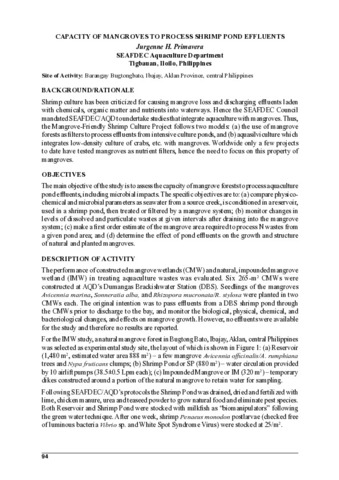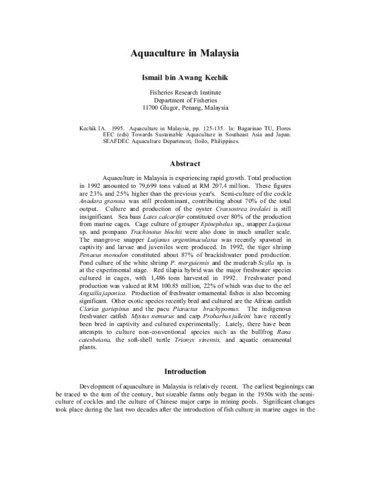Perlihatkan publikasi sederhana
Capacity of mangroves to process shrimp pond effluents.
| dc.contributor.author | Primavera, Jurgenne | |
| dc.date.accessioned | 2012-04-24T05:57:29Z | |
| dc.date.available | 2012-04-24T05:57:29Z | |
| dc.date.issued | 2004 | |
| dc.identifier.citation | Primavera, J. H. (2004). Capacity of mangroves to process shrimp pond effluents. In Promotion of mangrove-friendly shrimp aquaculture in Southeast Asia (pp. 94-103). Tigbauan, Iloilo, Philippines: Aquaculture Department, Southeast Asian Fisheries Development Center. | en |
| dc.identifier.uri | http://hdl.handle.net/10862/958 | |
| dc.description.abstract | Shrimp culture has been criticized for causing mangrove loss and discharging effluents laden with chemicals, organic matter and nutrients into waterways. Hence the SEAFDEC Council mandated SEAFDEC/AQD to undertake studies that integrate aquaculture with mangroves. Thus, the Mangrove-Friendly Shrimp Culture Project follows two models: (a) the use of mangrove forests as filters to process effluents from intensive culture ponds, and (b) aquasilviculture which integrates low-density culture of crabs, etc. with mangroves. Worldwide only a few projects to date have tested mangroves as nutrient filters, hence the need to focus on this property of mangroves. | en |
| dc.language.iso | en | en |
| dc.publisher | Aquaculture Department, Southeast Asian Fisheries Development Center | en |
| dc.subject | Penaeidae | en |
| dc.subject | Philippines | en |
| dc.title | Capacity of mangroves to process shrimp pond effluents. | en |
| dc.type | Meeting report | en |
| dc.subject.asfa | aquaculture effluents | en |
| dc.subject.asfa | community composition | en |
| dc.subject.asfa | culture effects | en |
| dc.subject.asfa | mangroves | en |
| dc.subject.asfa | pond culture | en |
| dc.subject.asfa | shrimp culture | en |
| dc.subject.asfa | water pollution | en |
| dc.subject.asfa | water quality | en |





